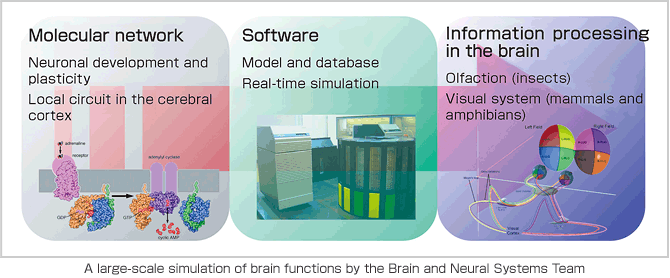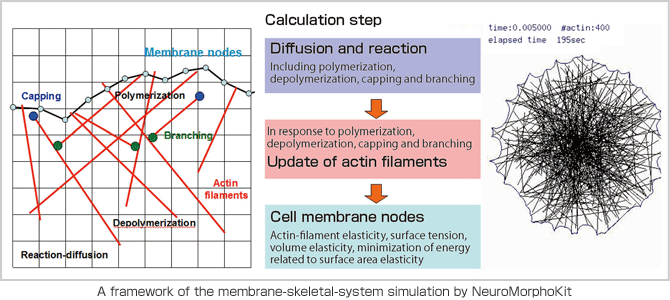
Brain and Neural Systems Team
Create a Brain on a Supercomputer
to Unravel the Functions of the
Brain and Nervous System

Brain and Neural Systems Team
Team Leader
Shin ISHII
Since the time of ancient Greece, the origin of intelligence, i.e., the function of the brain, has been one of the most intriguing mysteries to mankind. Since the advent of computers, the brain has often been compared with computers and the possibility of creating intelligence on a computer has been discussed repeatedly. In 1952, Hodgkin and Huxley conducted electrophysiological experiments on the giant axon of the squid and, based on the results, developed a model of the ion permeability property of the nerve-cell membrane as an electrical circuit (deterministic equation). They repeated experiments and introduced hypotheses such as the inactivation of sodium channels in order to explain the quantitative data they obtained. Later, it was actually demonstrated that the inactivation process was initiated by the chain of amino acid residue contained in the channel molecule. This was the world's first achievement in the field of systems biology and retains its scientific significance even today. They evaluated their model's validity through simulation using the then-state-of-the-art computational technology, a mechanical calculator. This successful study is suggestive in terms of the following two aspects. Firstly, the then-stateof- the-art computational technology played a crucial role in a hypothesisdriven biological study, that is, a study in systems biology. Secondly, the field of quantitative biology based on computational simulation has historically been led by studies on the brain and nervous system.
The conductance-based model of membrane potential constructed by Hodgkin and Huxley was later integrated into software such as "NEURON" and "GENESIS," both of which make it possible to simulate the use of a multicompartment model. "Kinetikit," a toolbox for biochemical simulation run on "GENESIS," was developed by Bhalla. With this toolbox, pioneering studies were conducted to describe synaptic plasticity, the fundamental function of the nervous system, by simulating biomolecular signal transduction. These represent the past history that the brain and nervous system has been an important target in "simulation-based biological studies." Recent advancements in measurement technology in life sciences have produced an enormous amount of experimental data, enabling modeling studies to extensively expand the range of their research targets. Even at the time of Hodgkin and Huxley, the modeling studies on the brain and nervous system stood as authentic "science" in which regularity is inferred from the tangible numbers obtained by measurement experiments.
Coming back to the present, the scale of simulation studies on the brain and nervous system is becoming increasingly larger in Europe and the United States. In Switzerland, Ecole Polytechnique Fédérale de Lausanne has been working on the "Blue Brain Project" with the full cooperation of IBM since June 2005. In 2007, it connected 8,192 CPUs together using a 4-racksystem IBM Blue Gene computer and succeeded in running simulations of a functional column of the cerebral cortex composed of 10,000 neurons. In the United States, the Pittsburgh Supercomputing Center and Salk Institute are conducting the "MCell" project to construct a detailed 3-D neuron model and examine the dynamics of each signal transduction molecule through Monte Carlo simulations. Unfortunately, studies on the brain and nervous system through a computational scientific approach have not attracted much interest in our country. The missions of our Brain and Neural Systems Team are, therefore, to launch a project unique to our country using one of the world's fastest next-generation supercomputers and promote computational scientific studies on the brain and nervous system that are performed by making full use of technology for large-scale computer simulations.

Let me introduce our projects using the next-generation supercomputer. The studies in Europe and the Unites States have been conducted under the dogma that the roles of functional elements in the brain and nervous system can be unraveled by re-creating "the microdynamics of a neural circuit or neuron," while ignoring the computational theory of "the macroscale function of the brain," that is, how information from the outside world is processed. Our team believes that it is important to reconsider this dogma, which is based on a constructive approach, and introduce a stance of computational theory. In other words, the brain functions as a whole under the interaction with the outside world (environment) and changes its functions by adapting to the environment, which is dynamic. The brain should primarily be considered to be such an information-processing and learning device. In such circumstances, the roles of elements such as neural circuits and neurons are dynamically determined in the processes of interaction with and adaptation to the environment. The behavior of the elements, therefore, should be dependent on information from the outside world as well as genetic information.
However, the human brain consists of at least 10 billion of neurons. Most of the parameters such as the connectivity between neurons and the expression or activation of various functional molecules in each neuron are unknown. As it is virtually impossible to construct a model of such a complicated system and to simulate the use of the model in a setting in a real external environment, the targets have to be limited. Therefore, the research projects our team focuses on are the visual system of mammals (humans in particular) and the olfactory system of invertebrates (insects in particular). Our goals by the time the next-generation supercomputer becomes available are to re-create the following: the dynamics of a local circuit of the cerebral cortex containing 105 neurons and 109 synapses, its local function to learn, and the spatiotemporal dynamics of the molecular network in a single neuron, which is involved in learning and development. For these purposes, we are currently working on the development of software such as "NEST" (a large-scale parallel neuron simulator) and "NeuroMorphoKit" (a membrane-skeletal-system simulator) and are conducting the research on the basic technologies necessary for software development. These will enable us to simulate the interaction of the whole visual system with the environment, by associating with the retina model and the eye movement model, both of which are also our research projects. Such simulations require combining many element models, so we are developing "PLATO," which is a common underlying platform for the construction of a large-scale model. Because the olfactory system in insects is composed of a relatively small number of neurons (105 neurons), we have built an environment including the database and software necessary to simulate the system of multi-compartment neuron models since the start of our research. In the aforementioned projects, RIKEN functions as the core facility. The studies are conducted at Kyoto University and the University of Tokyo in cooperation with the Okinawa Institute of Science and Technology and the Nara Institute of Science and Technology. Thus, the projects are being implemented under an all-Japan research system.

BioSupercomputing Newsletter Vol.2
- SPECIAL INTERVIEW
- Aiming to Become a Global Trendsetter in the Life Sciences by Making the Best Use of the Next-generation Supercomputer!
Computational Science Research Program Deputy Program Director
Ryutaro HIMENO
- A Message from the Team Leader
- Simulating Cell Phenomena by Recreating Cells as They Exist in Living Organisms
Cell Scale Team Team Leader
Hideo YOKOTA - Create a Brain on a Supercomputer to Unravel the Functions of the Brain and Nervous System
Brain and Neural Systems Team Team Leader
Shin ISHII - High-performance Computing Environment to Maximize the Potential of the Next-generation Supercomputer
High-performance Computing Team Team Leader
Makoto TAIJI
- Report on Research
- Protein Reaction Simulation Based on All-electron Calculation
Institute of Industrial Science, the University of Tokyo
Fumitoshi SATO / Toshiyuki HIRANO / Noriko UEMURA / Naoki TSUNEKAWA / Junichi MATSUDA - Full Eulerian Fluid-structure Coupled Method
Associate Professor at School of Engineering, the University of Tokyo
Kazuyasu SUGIYAMA - A Large-scale Simulation Model of Cortical Microcircuits: CMDN(Cortical Microcircuit Developed on NEST)
Brain and Neural System Team
Jun IGARASHI - Development of Next-generation Molecular Dynamics Simulation Programs
High-performance Computing Team
Hiroshi KOYAMA / Yosuke OHNO / Gen MASUMOTO / Aki HASEGAWA / Gentaro MORIMOTO
